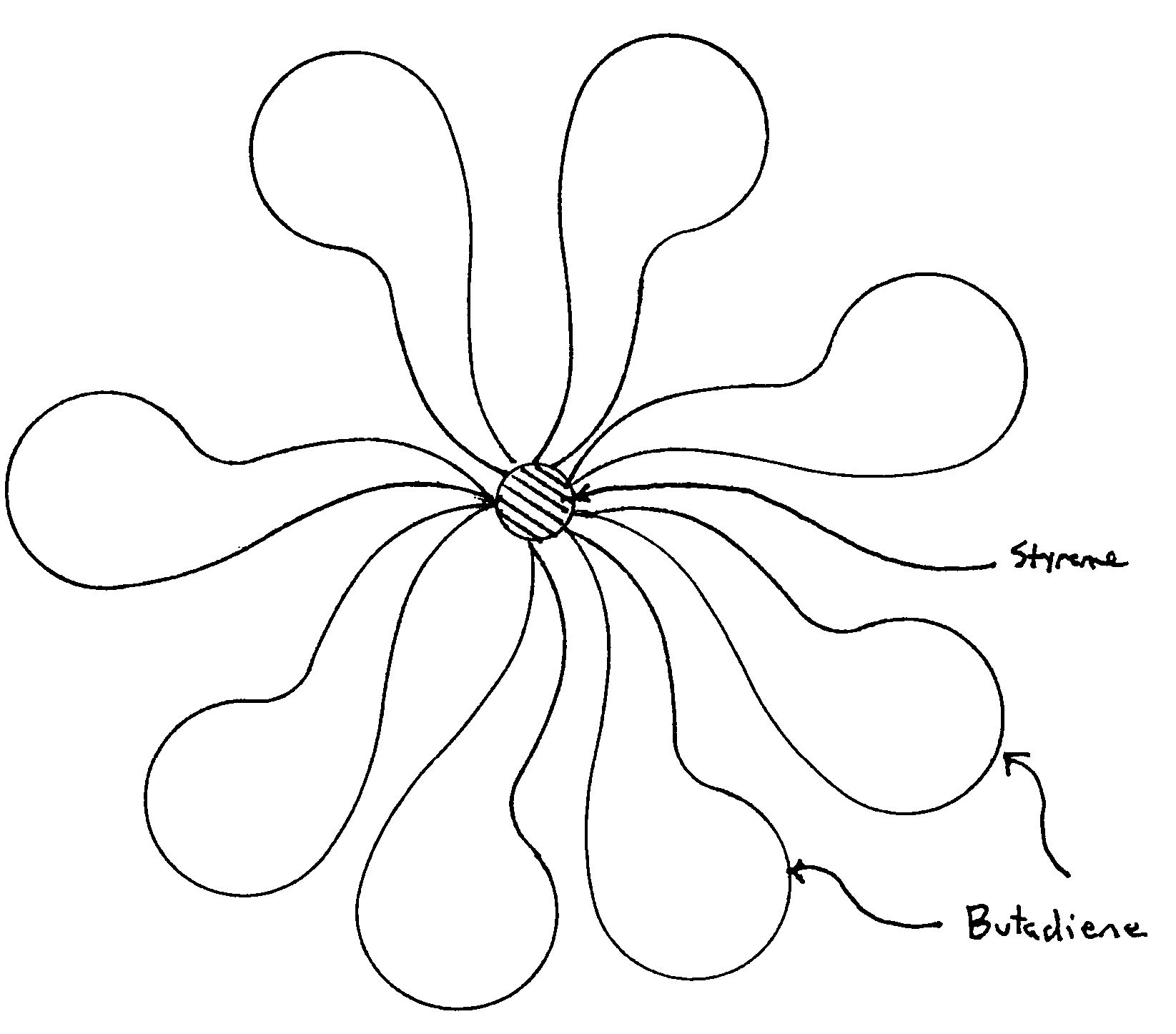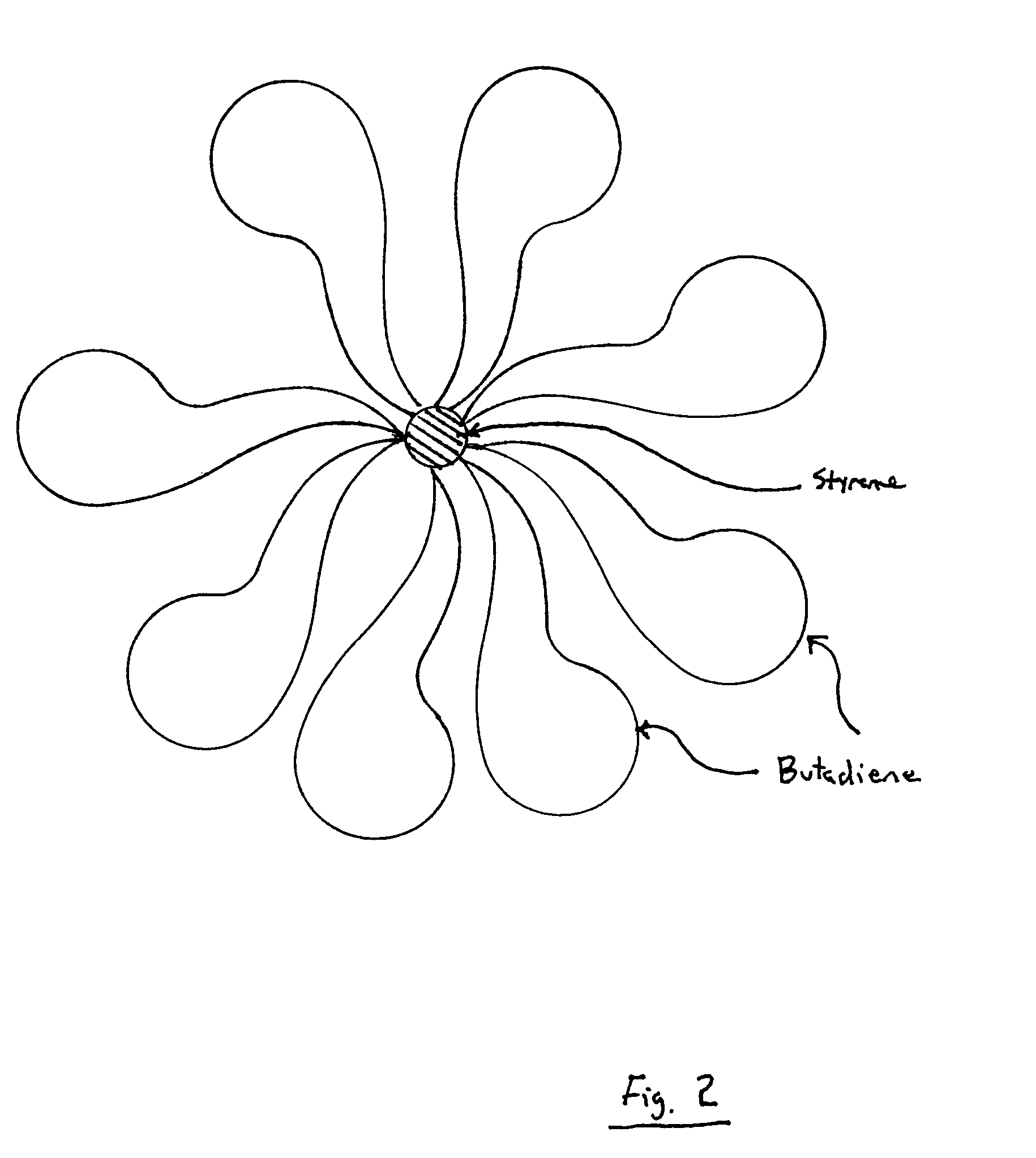Polymeric nano-particles of flower-like structure and applications
a polymer nanoparticle and flower-like technology, applied in the field of flower-like polymer nanoparticles, can solve the problems of difficult control of the size of nano-particles during polymerization and/or the surface characteristics of such nano-particles, difficult development of a process capable of reliably producing acceptable nano-particles, and degradation of matrix materials, i.e. rubber, characteristics, etc., to achieve low shrinkage properties, good tensile strength, and high hysteri
- Summary
- Abstract
- Description
- Claims
- Application Information
AI Technical Summary
Benefits of technology
Problems solved by technology
Method used
Image
Examples
example 1
Preparation of Flower-like Nano-particles
[0072]A 7.6 L polymerization reactor (R-11) equipped with external jacket heating and internal agitation was used for the preparation. The reactor was charged with 0.52 kg of hexane and 1 kg of butadiene / hexane blend (˜22%). The batch was then heated to 57° C. After the temperature stabilized, polymerization was initiated with 16 mL of a 0.5 M solution of di-lithium initiation agent in hexane. The di-lithium solution was made according to the above procedure.
[0073]The batch temperature was maintained at 57° C. for the duration of the polymerization. After 2 hours, the reactor was charged with 0.7 kg of styrene / hexane blend (33 wt % of styrene). After an additional two-hour reaction, the reactor was charged with 2.8 kg of hexane and then 50 mL of divinyl benzene (DVB). The temperature was maintained at 57° C. for another two-hour period. The reactor was then discharged and the product was dropped into an acetone / isopropanol (˜95 / 5) blend, and ...
examples 2 – 4
Examples 2–4
[0075]Three rubber compositions were prepared according to the formulation shown in Tables 1 and 2 by selectively using the synthesized flower-like polymer particles from Example 1 to replace 10 parts of butadiene rubber in the compound formulation. In each sample, a blend of the ingredients was kneaded by a method listed in Table 3. The final stock was sheeted and molded at 160° C. for 30 minutes.
[0076]
TABLE 1Composition for Mater Batch(pbw)Polybutadiene (HX301)100.00Carbon Black (N343)50.00Aromatic Oil15.00Zinc Oxide3.00Hydrocarbon Resin (tackifiers)2.00Santoflex 13 (antioxidants).95Stearic Acid2.00Wax1.00
[0077]
TABLE 2Composition for Final BatchSulfur~1.30Cyclohexyl-benzothiazole sulfenamide (accelerator)1.40Diphenylguanidine (accelerator)0.20
[0078]
TABLE 3Mixing ConditionsMixer: 300 gAgitation Speed: 60 rpmBrabenderMater Batch StageInitial Temperature110° C. 0 minCharging polymers0.5 minCharging oil and Carbon Black5.0 minDropFinal Batch StageInitial Temperature75° C. ...
PUM
| Property | Measurement | Unit |
|---|---|---|
| mean average diameter | aaaaa | aaaaa |
| diameter | aaaaa | aaaaa |
| diameter | aaaaa | aaaaa |
Abstract
Description
Claims
Application Information
 Login to View More
Login to View More - R&D
- Intellectual Property
- Life Sciences
- Materials
- Tech Scout
- Unparalleled Data Quality
- Higher Quality Content
- 60% Fewer Hallucinations
Browse by: Latest US Patents, China's latest patents, Technical Efficacy Thesaurus, Application Domain, Technology Topic, Popular Technical Reports.
© 2025 PatSnap. All rights reserved.Legal|Privacy policy|Modern Slavery Act Transparency Statement|Sitemap|About US| Contact US: help@patsnap.com



